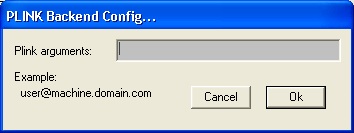uCon HomePage
Backend PLINK (SSH) Option
New as of Mar16, 2017: Update to putty-0.68!
uCon supports a "plink" backend.
Plink is the command line portion of the open-source PuTTY client (see
copyright below). For details on PuTTY, refer to
http://www/chiark.greenend.org.uk/~sgtatham/putty. In the nutshell,
this gives uCon the ability to connect to remote servers via SSH and
RLOGIN, with SSH being the primary motivation for this capability.
The plink connection dialog box is started through
the menu item Config->Backends->Plink and allows the user
to enter the arguments that would normally be passed to plink at a
command line interface (see below for new-as-of-mar-2015 option)...

To initiate the SSH client, type in the username
followed by an '@' sign followed by the name of the machine you wish to
connect to (refer to the example in the dialog box), then click OK.
New as of Aug 2015: To override the default SSH port, you can append a ":portnum" to
the end of the string or prefix the line with "-P portnum"...
username@machine.domain.com:PORT
or
-P PORT username@machine.domain.com
Theoretically, any set of command line arguments that
could be passed to plink.exe at a console window should be able to be
placed in this dialog box as an argument to plink. That being said,
below is the help output of "plink --help" (version 0.68) when run at the command line...
Plink: command-line connection utility
Release 0.68
Usage: plink [options] [user@]host [command]
("host" can also be a PuTTY saved session name)
Options:
-V print version information and exit
-pgpfp print PGP key fingerprints and exit
-v show verbose messages
-load sessname Load settings from saved session
-ssh -telnet -rlogin -raw -serial
force use of a particular protocol
-P port connect to specified port
-l user connect with specified username
-batch disable all interactive prompts
-proxycmd command
use 'command' as local proxy
-sercfg configuration-string (e.g. 19200,8,n,1,X)
Specify the serial configuration (serial only)
The following options only apply to SSH connections:
-pw passw login with specified password
-D [listen-IP:]listen-port
Dynamic SOCKS-based port forwarding
-L [listen-IP:]listen-port:host:port
Forward local port to remote address
-R [listen-IP:]listen-port:host:port
Forward remote port to local address
-X -x enable / disable X11 forwarding
-A -a enable / disable agent forwarding
-t -T enable / disable pty allocation
-1 -2 force use of particular protocol version
-4 -6 force use of IPv4 or IPv6
-C enable compression
-i key private key file for user authentication
-noagent disable use of Pageant
-agent enable use of Pageant
-hostkey aa:bb:cc:...
manually specify a host key (may be repeated)
-m file read remote command(s) from file
-s remote command is an SSH subsystem (SSH-2 only)
-N don't start a shell/command (SSH-2 only)
-nc host:port
open tunnel in place of session (SSH-2 only)
-sshlog file
-sshrawlog file
log protocol details to a file
-shareexists
test whether a connection-sharing upstream exists
As of this writing, the only thing that has
been tested with uCon is the default SSH client running through plink release 0.68; however, you're
welcome to experiment and let me know what works and doesn't work.
NOTE:
The plink exectuable is verified with an md5 checksum. To use a
newer/different putty, you'll need to override the md5sum using the
PLINKVERIFY shell variable within uCon. To do this, set the variable to
IGNORE (to bypass verification) or the md5sum calculated on the
new plink.exe file you put in the uCon installation directory...
./ucon -D PLINKVERIFY=IGNORE
PuTTY LICENCE file:
PuTTY is copyright 1997-2017 Simon Tatham.
Portions
copyright Robert de Bath, Joris van Rantwijk, Delian Delchev, Andreas
Schultz, Jeroen Massar, Wez Furlong, Nicolas Barry,Justin Bradford, Ben
Harris, Malcolm Smith, Ahmad Khalifa, Markus Kuhn, Colin Watson,
Christopher Staite, and CORE SDI S.A.
Permission is hereby
granted, free of charge, to any person obtaining a copy of this
software and associated documentation files (the "Software"), to deal
in the Software without restriction, including without limitation the
rights to use, copy, modify, merge, publish, distribute, sublicense,
and/or sell copies of the Software, and to permit persons to whom the
Software is furnished to do so, subject to the following conditions:
The above copyright notice and this permission notice shall be included in all copies or substantial portions of the Software.
THE
SOFTWARE IS PROVIDED "AS IS", WITHOUT WARRANTY OF ANY KIND, EXPRESS OR
IMPLIED, INCLUDING BUT NOT LIMITED TO THE WARRANTIES OF
MERCHANTABILITY, FITNESS FOR A PARTICULAR PURPOSE AND
NONINFRINGEMENT. IN NO EVENT SHALL THE COPYRIGHT HOLDERS BE
LIABLE FOR ANY CLAIM, DAMAGES OR OTHER LIABILITY, WHETHER IN AN ACTION
OF CONTRACT, TORT OR OTHERWISE, ARISING FROM, OUT OF OR IN CONNECTION
WITH THE SOFTWARE OR THE USE OR OTHER DEALINGS IN THE SOFTWARE.
New, unusual feature (as of Mar 2015)
There's a new totally disjoint option to this dialog box...
If
you set the "Plink arguments" textbox to "CMD" (don't include the
quotes), then the console window of uCon will open up a CMD shell. For
reasons beyond the scope of this text, I had a use for this at one
point.
I left it in uCon only to provide an alternative remote access mechanism to the PC through telnet...
If you set up the telnet server to be active, then you can telnet into uCon from another machine and access a CMD shell.
Obviously
there are other more modern ways to do the same with more capability
(i.e. VNC), but its here to use if you can find a reason.
Note that this applies to the
startup dialog box of uCon as well.

